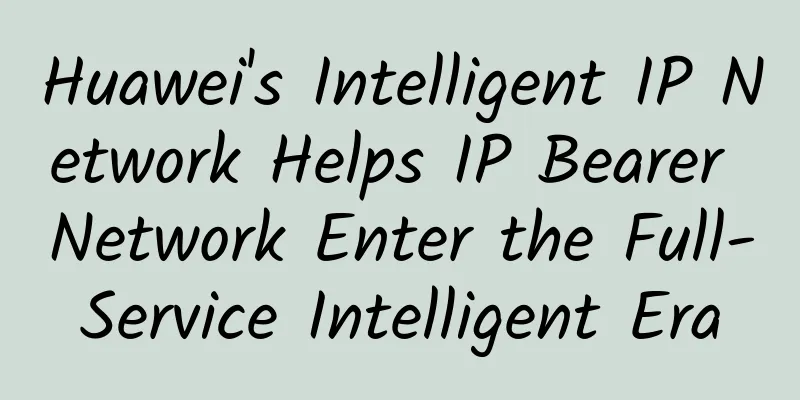Huawei's Intelligent IP Network Helps IP Bearer Network Enter the Full-Service Intelligent Era

|
[Shenzhen, May 19, 2020] Today, during Huawei's 2020 Analyst Conference, Huawei released an intelligent IP bearer network solution for operators. Adhering to the three core concepts of intelligent ultra-broadband, intelligent connection, and intelligent operation and maintenance, Huawei can calmly respond to the new demands brought by 5G in thousands of industries and millions of enterprises moving to the cloud, and achieve SLA commitments for key services such as 5G 2B and cloud dedicated lines, enabling operators' commercial success in the 5G and cloud era. Chen Jinzhu, President of Huawei Metro Router Over the past two decades, with the continuous changes in services, IP networks have gone through the Internet era and the Triple-play era. Currently, with the advent of 5G and cloud, operators' IP networks have entered the era of full-service intelligence. Chen Jinzhu, President of Huawei's Metro Router Domain, said that 2B services are the biggest change in the era of full-service intelligence. According to GSMA's forecast, by 2026, 5G 2B will bring $620 billion in ICT market space, covering eight major industries such as medical care, smart manufacturing, and energy. While services such as 5G 2B bring huge business opportunities, they also bring demands for bandwidth, experience assurance, and high reliability. Taking 5G smart grids as an example, differential protection requires end-to-end delay to be less than 15ms and bearer network to be less than 2ms. If the delay exceeds the standard, it may cause power protection failure and cause accidents. In response to the demands of new services in the era of full-service intelligence, Huawei has launched the Intelligent IP Bearer Network Solution, which fully introduces intelligence into the IP bearer network to help operators build a new generation of IP networks with intelligent ultra-broadband, intelligent connectivity, and intelligent operations and maintenance. l Intelligent ultra-broadband. First of all, ultra-broadband network is the foundation. The current IP network is moving from 100GE to 400GE. Compared with 100GE, 400GE has the advantages of saving optical fiber and improving network utilization. Huawei is the industry leader in 400GE. It is the first in the industry to support end-to-end 400GE networking from aggregation to backbone, supports the industry's only 10KM/40KM/80KM full-distance optical module, and achieved the industry's first 400GE commercial use in 2019. At the same time, in response to the problem that all services in traditional networks share bandwidth resources and key service bandwidth cannot be guaranteed, Huawei took the lead in the industry to propose FlexE network slicing technology to achieve hard isolation between different service flows and provide 100% committed bandwidth guarantee for key services such as 5G 2B. At the press conference, Chen Jinzhu introduced that in the 5G smart medical care carried out by Henan Mobile and Huawei in 2019, a high-quality private network was provided for medical services based on FlexE slicing, achieving zero packet loss for medical services. l Intelligent connection. Based on the next-generation network protocol SRv6, services can be quickly provisioned, latency can be promised, and network reliability can be achieved. Taking latency promise as an example, the SLA requirements for different services in the 5G and cloud era are diverse, and the network must be able to provide connections based on the service SLA. The service provisioning of traditional networks is statically configured, and it is difficult to configure network resources in real time according to service intent. Based on SRv6, the best path can be intelligently selected and adjusted in real time according to service intent, network congestion status, etc., to continuously provide the best connection experience and achieve latency promise. For example, in 2019, in order to reduce the latency of enterprises going to the cloud, MTN took the lead in introducing SRv6 in the network. By identifying services and intelligently selecting routes based on SRv6, it achieved the optimal latency guarantee for cloud private line services. At the press conference, Chen Jinzhu said that Huawei is committed to promoting the development of the SRv6 industry and large-scale commercial use. It is the largest contributor to the SRv6 standard and has participated in more than 59% of the standard formulation. So far, more than 20 commercial deployments have been achieved worldwide. l Intelligent operation and maintenance. Based on iMaster NCE, the industry's first intelligent management platform that integrates management, control, and analysis, Huawei can help customers achieve intelligent operation and maintenance throughout the entire life cycle, including planning, construction, maintenance, and optimization. Taking Beijing Unicom as an example, key areas and key events such as Daxing Airport and the future Winter Olympics have increasingly higher requirements for Beijing Unicom's network reliability. Therefore, Beijing Unicom introduced NCE+iFIT flow detection technology to achieve real-time quality visualization and minute-level fault location, ensuring high reliability of services such as 5G 2B and high-quality private lines. After deploying NCE and iFIT, the average daily user complaints decreased by 80%. So far, iMaster NCE has been commercially deployed in more than 100 operators around the world, helping customers achieve automatic site addition, cloud-network collaboration, and gradually moving towards network autonomous driving. As a world-leading intelligent IP network solution provider, Huawei has been investing in research and development for more than 20 years. It has ranked first in the market share of operator routers for two consecutive years. Its products and solutions serve more than 140 countries and regions around the world. Facing the 5G and cloud era, the intelligent IP bearer network characterized by intelligent ultra-broadband, intelligent connection and intelligent operation and maintenance is an inevitable choice and will become an inevitable trend in the development of operator IP networks in the next 10 years. Huawei will continue to work with customers to jointly build an intelligent IP bearer network, lead the operator IP bearer network into the era of full-service intelligence, and help customers achieve business success in the 5G and cloud era. |
<<: "Edge computing" has become the core keyword of 5G
>>: 5G technology has already approached the Shannon limit, what else can 6G do?
Recommend
Smart cities around the world: six innovative success stories
[[406966]] It is estimated that at least 180,000 ...
UAE operator e partners with Nokia Bell Labs to explore industrial AI applications
UAE-based telecom service provider e&T and No...
Getting started with SD-WAN, just read this article
In 2019, the global market for SD-WAN grew by 70%...
RAKsmart: Hot-selling servers, Hong Kong/Korea/Japan/US San Jose dedicated servers starting from $46/month
RAKsmart released information about its promotion...
Tell you the real strength of the four major communication operators' 5G
Recently, our country has determined the 2020 &qu...
China Academy of Information and Communications Technology: In November, domestic 5G mobile phone shipments reached 20.136 million units, accounting for 68.1%
On December 10, the China Academy of Information ...
SaltyfishTech Germany 9929 package free upgrade, 15% off for quarterly payment, $19/quarter-dual core/1GB/15GB/1.15TB@300Mbps
SaltyfishTech (咸鱼云) recently upgraded the Frankfu...
GINERNET: €19.95/year - 1GB/10G NVMe/1TB/Spain VPS
Is there anyone who needs a Spanish VPS? GINERNET...
Zhang Xuezhi from the Ministry of Industry and Information Technology: We will continue to support all parties in the industry to jointly promote the development of 5G applications
[[411408]] From July 13 to 15, the 2021 China Int...
5G and AI Use Cases - How 5G Helps Implement Artificial Intelligence
Michael Baxter says 5G will unlock the potential ...
Foreign media: As of June, South Korea's 5G users have exceeded 16 million
On August 11, according to foreign media reports,...
Introduce the commonly used encoders and decoders in Netty
[[359182]] The previous article introduced Netty ...
5G is here, and you can’t hide from it
5G has gradually entered our lives with the resea...
Important factors of data center energy efficiency: latent heat and sensible heat
Talking about the PUE value of data centers has a...
China leads the world in quantum technology patents
[[388060]] Quantum technology has become the comm...

![[6.18] 80VPS 50% off on all KVM/XEN, special KVM annual payment starting from 199 yuan, multiple computer rooms in Hong Kong/USA available](/upload/images/67cac3292e482.webp)







